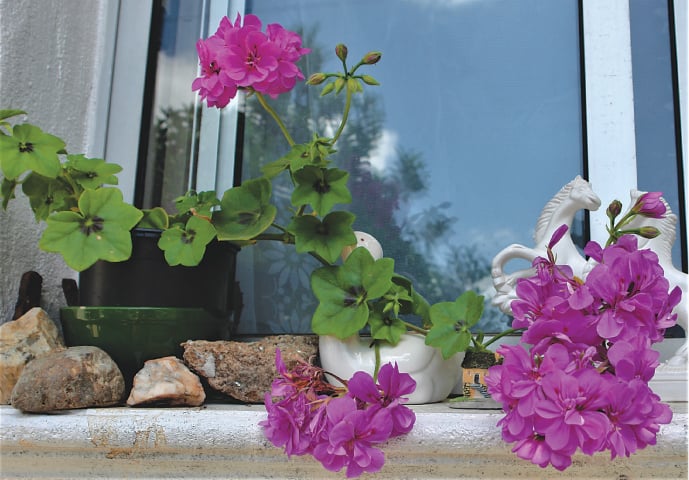
Pot plants, be they indoor or out, tend to be taken for granted until or unless they decide to give up the ghost and die.
The two most common reasons for the death of pot plants are over-watering and starvation. It is the starvation aspect that we will take a look at here.
To be happy, healthy and thrive as nature intended, all plants require varying amounts of water and food. Whilst the majority of people do remember to water pot plants from time to time, remembering to feed them seems to be quite a different matter.
Unlike plants growing directly out in the garden, whose roots can stretch out and travel in search of adequate nourishment, pot plants are limited to whatever soil mix is contained in the pot/ container they are growing in. Unless topped up on a regular basis, the soil’s nutrient value can be used up in a surprisingly short span of time.
House plants should to be moved into slightly larger pots with fresh potting mix, once a year, to ensure they are healthy and happy
A flourishing rubber plant in a large pot may suddenly lose its vigour, begin shedding its leaves or suddenly stop growing, and its owner may think it needs more or less natural light, require more or less water. But the odds are that it is hungry and, while a treat of liquid fertiliser — organic if possible, every 6-8 weeks — may cheer it up, what it really needs is to be repotted in a completely fresh mix of soil and compost.
Generally speaking, pot plants should be repotted on an annual basis, the time of repotting depending on the plant species. Flowering pot plants should only be repotted either before or after they flower because, if their roots are disturbed at a point when they are concentrating all of their energy on producing flowers, they will have no energy to spare for dealing with the inevitable shock of being transplanted, and may die.
Signs that plants are asking to be repotted include:

Plants have become top heavy, their growing parts being larger than their current pot, and over-balance in the slightest breeze.
They visibly lack vigour, stop growing and yet no pests are visible.
Plant roots have grown out of the drainage hole in the base of the pot/container.
Plant roots are so congested that they begin pushing the plant up and out of its pot.
There is a visible build-up of whitish salts and minerals on the soil surface or on the outside of the actual pot, the latter being especially noticeable on unglazed clay pots.
Repotting plants isn’t a difficult process, but remember to be gentle with your plants; stems and roots can often be surprisingly brittle and breakages are best avoided.

What you need:
Select suitable new pots or recycle existing pots which have first been thoroughly scrubbed out and disinfected to eradicate any trace of pests and diseases. If a plant has outgrown its 8-inch diameter pot for instance, re-pot it into one with a 10- or 12-inch diameter, and so on.
A supply of fresh, preferably organic, mix of soil/ compost.
A supply of pot shards — these are broken pieces of clay pots — to enhance drainage.
Gardening gloves to protect your hands and nails.
How to proceed:
Prepare the new pot/ container by laying a few pot shards, at different angles, over the drainage hole inside the base of the pot. These pot shards will greatly assist in keeping the drainage hole free of obstruction, so that any excess water can easily drain out.

Cover the pot shards with a layer of new soil/compost.
Carefully remove the plant to be repotted from its existing pot/ container.
Do this by laying the pot/ container on its side, hold the plant firmly at the point where its stem enters the soil and, with your other hand, tap around the outside of the pot and then on its base until the plant and any attached soil slides out in one piece.
Some plants, especially if their roots have grown out of the pot base, can be difficult to extract, and you need to cut off any roots poking through the pot base, but persevere until the task is accomplished. If the top of the pot is smaller in diameter than the middle or base, it may be necessary to break the pot. A few sharp taps with a hammer should work.
Carefully brush off as much of the old soil/ compost as possible and, if the roots are compacted, try to spread them out a little without causing breakage.
Put just enough new soil/ compost in the new pot/ container for the plant to sit on while ensuring that the crown or bottom of the plant’s stem (the place where plant meets roots) is planted at exactly the same depth in the soil as it was before. Planting it too deeply in the soil/compost can cause the crown/ stem to rot.
Then, carefully trickle soil/ compost all around the plant, gently pushing it down with your fingers as you go, until the pot is almost full and the plant settled nicely into place.
Water well, a bit at a time being best, allow any excess water to drain, and there you have it. Your pot plant, correctly cared for of course, should be happy, healthy and well nourished.
Feed it with extra liquid manure every three months if you like, but it is not necessary.
The old, nutrient-depleted soil, can be recycled in the compost heap if, but only if, the plants that were previously growing in it were completely disease free.
Please continue sending your gardening queries to zahrahnasir@hotmail.com. Remember to include your location. The writer does not respond directly by email. Emails with attachments will not be opened
Published in Dawn, EOS, October 17th, 2021














































Dear visitor, the comments section is undergoing an overhaul and will return soon.